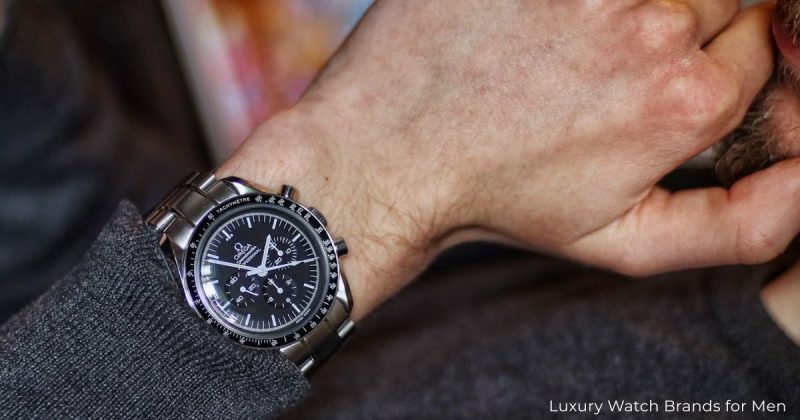
We offer a vast selection of timeless luxury watches for men, ranging from incredibly practical water-resistant models to highly sought-after limited editions that are truly unmatched in the world of horology. With so many choices available, you might be asking yourself: what distinguishes one luxury watch from another, and how can I determine which watch is the ideal choice for my style and needs? Furthermore, a fundamental question remains: what specific elements and characteristics elevate a timepiece to the coveted status of a luxury watch?
To assist you in navigating this intricate landscape and to empower you to make an informed decision, we have meticulously compiled a comprehensive guide featuring essential details and insights on eight distinguished luxury watch companies. Our goal is to provide you with the necessary information to confidently select the perfect watch that resonates with your individual preferences and aspirations. Luxury Watch Brands for Men are defined not by a strict standard but by three essential pillars: exceptional performance, superior craftsmanship, and impeccable design. Each prestigious brand we’ve curated exemplifies these qualities, representing the pinnacle of watchmaking excellence.
8 Best Luxury Watch Brands for Men
1. Breitling
Breitling is a Swiss luxury watch manufacturer based in Grenchen, Switzerland. Breitling watches are designed to withstand intensive use in the most trying conditions. Every Breitling watch is a COSC-certified chronometer, while only 3% of Swiss watch production is COSC-certified. Such a guarantee attracts the interest, mainly, from divers and those in aviation. Characteristics commonly found on the Breitling dial include a very legible face and a mechanical direct winding system. Breitling offers interchangeable straps made out of leather, rubber, or ECONYL fabric, a characteristic not often found in luxury watches.
2. Cartier
Cartier got its roots in Paris in 1847, growing to be a French brand of luxury items, which produced and designed excellent watches and jewels. In 1904, the Santos was designed for one of Cartier’s pilot friends and is, to this day, one of the brand’s most popular models. Earlier in the years, the designs were mainly loved by King Edward VII, and most of the designs used to refer to it as “The jeweller of kings and the king of jewellers.” Today, the name has gained recognition worldwide for its watches. It stands to be the one with great design and also comfortable in terms of shape.
3. IWC Schaffhausen
In 1868, an American engineer and watchmaker, Florentine Ariosto Jones of Boston, established the International Watch Company in a bid to integrate Swiss craftsmanship with American technology. In addition to F.A. Jones, the men set up the only north-eastern Switzerland watch manufacturer in the town of Schaffhausen. These watches have, therefore, come to be known for their functionality and luxurious appeal. Some even say to impress a layman, wear a Rolex, but to impress a collector, wear an IWC Schaffhausen. These watches reflect the latest in timekeeping technology, most notably the Portugieser, so smart that it will provide the precise day, date, and moon phase for the next 480 years and beyond.
4. Jaeger-LeCoultre
This particular luxury watch brand is distinct from others in several ways. They have perfect and beautiful lines and meticulous attention to detail. Founded by Antoine LeCoultre in 1883, Jaeger-LeCoultre was the world’s most precise measuring instrument back then. Inventing revolutionary concepts inside their headquarters is the basis for building these luxurious timepieces that were created then and still exist today.
This innovation includes 1,200 calibers in its time (most have only a handful), a keyless system to rewind watches, 400 patents, and the creation of the iconic Reverso, its most iconic timepiece even still today. JLC has unprecedented control over the quality and attention to detail of their watches, as, unlike most manufacturers, they make their cases, dials, and hands in-house. It is this approach to watch-making that continues to set the Jaeger-LeCoultre apart.
5. Nomos Glashutte
Unlike many of the other luxury watches featured here, Nomos Glashutte is based in Germany and didn’t get its start until the late 1900s, after the fall of the Berlin Wall. Known for its clean and modernist aesthetic, this luxury watch manufacturer aligns itself with handcrafted industrial production and design ideals with functionality. NOMOS currently provides 13 variations of hand-wound and automatic mechanical watches. In 2018, Nomos Glashutte became the second non-Swiss brand to win the Grand Prix d’Horlogerie de Genève (GPHG), the Oscars of the watch world, with the Tangente Update model.
6. Omega
Omega watches are perhaps most famously known as the Official Timekeeper of the Olympic Games, but these watches are renowned for intricate detail, stunning design, and quality workmanship. Established in 1848 in La Chaux de Fonds, Switzerland, as Louis Brandt & Fil, the brand renamed itself in 1903 after producing the world-famous 19 caliber watch named Omega. A sense of exclusivity is maintained over this luxury watch brand through aggressive advertising campaigns focused on major sporting and movie events, along with various notable celebrity endorsements. Omega watches can often be spotted on the wrists of Daniel Craig, Prince William, George Clooney, Tom Hanks, and Nicole Kidman.
7. TAG Heuer
Founded in Switzerland in 1860 by Edouard Heuer and later acquired by French luxury goods company Techniques d’Avant Garde, TAG Heuer bears the name we’ve all come to recognize. Early on, in 1911, the company began creating timepieces that were used not only in automobiles, aircraft, and boats but also for timekeeping during ski and car racing events, even Formula One.
In 1962 Heuer was the first watch in space when John Glen piloted the Mercury-Atlas 6. Some of today’s lines are Formula One, Aquaracer, Carrera, Monaco, and Autavia. More recent models include the Monaco V4, which is powered by belts rather than gears; the Carrera Calibre 360, the first mechanical wrist chronograph to measure and display time to 1/100 of a second; and the Monaco 69, where the wearer can switch between a digital chronograph and a more traditional mechanical movement.
8. Zenith
Zenith is a Swiss luxury watchmaker that began in 1865 by Georges Favre-Jacot. It is one of the only Swiss watch manufacturers still producing its movements in-house and not outsourcing as many luxury brands do today. Not perhaps as well known as some other watch brands, Zenith is iconic among luxury watch collectors. In 1988, Rolex developed a self-winding Daytona based on a movement manufactured by Zenith. At the time, it was the only movement that met the high standards of the Rolex watchmakers.
The Zenith El Primero gained popularity during this time as it was the model that housed the movement used to help build the Rolex Daytona. Zenith is also known to withstand even the harshest of elements. In 1970, the first El Primero was strapped to the landing gear of an airplane crossing the Atlantic Ocean between Paris and New York. At temperatures of -62 degrees Celsius and an altitude of 10,000 feet, the watch remained unscathed and still maintained its accuracy within a second.
Positive and Negative Factors of Buying a Luxury Watch
Positive Factors
- Investment Potential: One of the significant advantages of acquiring a luxury watch is its potential as a sound investment. Unlike many consumer goods that depreciate rapidly, certain luxury timepieces tend to appreciate over time. This appreciation can make them a worthwhile asset in a diversified investment portfolio. The investment aspect adds a layer of appeal beyond simply owning a beautiful object.
- Exceptional Craftsmanship: Luxury watches stand apart due to their exceptional craftsmanship. These are not mass-produced items; instead, they are meticulously crafted by skilled artisans. The attention to detail is remarkable, often involving hand-finishing and intricate movement assembly. The use of high-quality materials, such as precious metals, rare gemstones, and durable alloys, further enhances their value and longevity.
- Symbol of Prestige and Status: Owning a luxury watch can serve as a symbol of prestige and status. It is often perceived as an indicator of wealth and success, reflecting a certain level of achievement. The association with luxury brands and their exclusive image reinforces this perception. A luxury watch can communicate a sense of personal style and accomplishment.
- Long-Lasting Durability: High-end watches are engineered for durability, designed to withstand the test of time and various environmental challenges. They are constructed with robust materials and undergo rigorous testing to ensure their resilience. This durability means that a luxury watch is not merely a fleeting purchase but a long-term investment that can be enjoyed for many years.
Potential Drawbacks of Luxury Watches
- Elevated Price Point: A significant negative aspect of luxury watches is their undeniably high cost. Acquiring one represents a substantial financial investment, often requiring a considerable outlay of funds that could be allocated to other assets or experiences. This makes them inaccessible to a large portion of the population and necessitates careful consideration of one’s budget and financial priorities before purchase.
- Ongoing Maintenance Requirements: Luxury watches, particularly those with intricate mechanical movements, typically demand regular and specialized maintenance services to ensure optimal performance and longevity. These maintenance procedures, which might involve cleaning, lubrication, and component replacement, can incur considerable expenses over the lifespan of the watch. Furthermore, scheduling and completing these services can be a time-consuming process, requiring careful planning and coordination with authorized service centers.
- Vulnerability to Theft: Due to their inherent high value and desirability, luxury watches unfortunately present an increased risk of theft. Owners must exercise caution and take appropriate security measures to protect their investments from potential criminal activity. This might involve securing the watch in a safe when not in use, being discreet about wearing it in certain environments, and ensuring adequate insurance coverage in the event of loss or theft.
- Potential for Value Depreciation: While some highly coveted and limited-edition luxury watches may appreciate in value over time, it’s important to recognize that this is not a universal phenomenon. Many luxury watches, particularly those that are not particularly rare or in high demand, can depreciate, especially shortly after purchase. This depreciation can represent a financial loss for the owner should they decide to sell the watch in the future, highlighting the speculative nature of luxury watch ownership as an investment.
Choose the Perfect Luxury Watch
Luxury watches are more than just timepieces—they are investments, heirlooms, and expressions of fine craftsmanship. Brands like Breitling, Cartier, and IWC Schaffhausen each offer unique designs and technical expertise, catering to a variety of preferences and lifestyles. Whether you’re drawn to the aviation heritage of Breitling, the timeless elegance of Cartier, or the horological innovation of IWC, there’s a perfect watch to suit your needs. These brands, along with the others we’ve highlighted, represent the pinnacle of watchmaking, blending artistry, tradition, and precision engineering.
As you explore the world of luxury watches, consider what matters most to you—style, movement, heritage, or investment potential. A well-chosen timepiece is more than an accessory; it’s a statement of individuality and a testament to the enduring craftsmanship of fine watchmaking. By selecting a watch that resonates with your aesthetic and values, you’re not only acquiring a functional piece of art but also a lasting legacy that can be treasured for generations.





